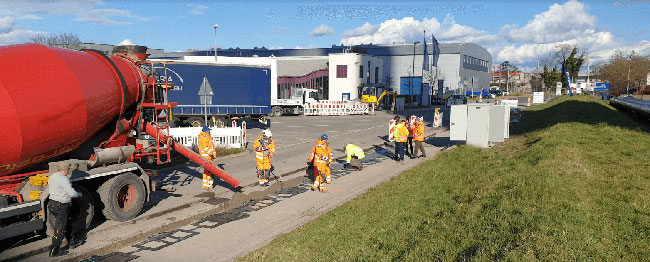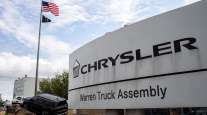Staff Reporter
Michigan to Test Roads With Underground Coils for EV Charging

[Stay on top of transportation news: Get TTNews in your inbox.]
A Detroit roadway where electric cars and trucks can recharge via a wireless device while traveling or parked is planned as part of a new venture between Michigan and Israeli company Electreon.
Michigan Department of Transportation is providing $1.9 million toward a five-year pilot project with Electreon, which bills itself as a pioneer in wireless electric vehicle charging, to fund the undisclosed remainder of the total cost.
It involves establishing a scalable wireless public in-road EV charging network, while using knowledge gained to develop a path forward for Michigan to implement and manage such a system statewide.

Mueller
State Transportation Director Paul Ajegba noted, when recently announcing the agreement, that Michigan intends to become a national leader in creating a wireless in-road EV charging network.
“We now can work toward better policy and regulatory framework that provides a welcoming environment for this unique technology. Ultimately, the research and work conducted on this project will help lead to large-scale deployment across Michigan and the U.S.,” Ajegba said.
This development follows a February deal with Electreon to turn a one-mile section of road in Detroit’s Michigan Central District 14th Street and U.S. Route 12 (Michigan Avenue) into a wireless EV recharging road system.
Michele Mueller, MDOT’s connected, automated and electrification senior project manager, explained to Transport Topics that only EVs equipped with an Electreon receiver will be able to recharge (via inductive charging) on the wireless electric road.
“Once the infrastructure is installed, tested and open to traffic, those vehicles would be able to utilize the system,” she said, adding that the electricity will come from the grid.
Stefan Tongur, Electreon vice president of business development, explained that in-road copper coil segments are buried about three inches under the surface and activated to transfer energy to an EV battery (through magnetic induction) to charge an EV as it moves or is parked above the underground coils.
A management unit next to a road transfers energy from the electricity grid to the in-road infrastructure and communicates in real time with EVs that have receiver units installed under the chassis to receive energy. Then road coil segments transmit energy directly to the battery.
Since an EV’s speed affects the amount of electricity it receives while driving along the specially modified roadway, faster vehicles receive less of a charge since they pass over segment coils faster.
“It’s important to keep in mind that the road is completely passive and only activates when a licensed vehicle passes over the coils under the roadway. Prior to the installation of each system, a sufficient amount of safety work is done in advance to identify safety routines and energy transfer control and to make sure that the technology is safe for humans, animals and the surrounding environment,” Tongur said.

Laying the wireless road in Karlsruhe, Germany (Electreon)
When asked about safety and if snow is an impediment, Tongur said energy transfers are unaffected by snow and ice since coil segments (insulated in rubber) are below surface and covered by asphalt pavement.
“The system was deployed in Sweden in near-arctic conditions — below freezing temperatures with snow and rain,” he said. “The energy transfer between the coil segments and the receivers is not affected by water or other liquid substances on the road.”

Road segments are placed in Gotland, Sweden. (Electreon)
Tongur touted advantages of wireless charging, especially for heavy trucks, because it enables EVs to charge while traveling rather than having to stop for plug-in charging that can result in high electricity demand for charging EV fleets.
“Unlike other solutions, wireless charging offers effortless, time-saving charging. Less downtime is needed to charge as trucks can enjoy ‘top-up’ charging throughout the day and operational hours,” he said. “This technology reduces the need for large batteries and extensive grid connection capacity, flattening the electrical demand curve, all of which significantly lowers costs and enables better management of transport energy.”
Tongur said wireless EV charging can be installed in public roads, tollways, loading docks, highways, parking lots and at fleet depots, enabling EV recharging throughout fleet operational hours.
“The technology works best in use cases which involve circular or repeated routine routes and could be utilized by heavy-duty trucks while driving on a roadway, within a shipyard or even while at loading docks,” he said.
The deal with MDOT calls for analyzing benefits from a wireless electrical road such as with electrical grid loads, future costs for large-scale electrification of the transportation sector and potential integration into the state’s 2045 electrification strategy.
Want more news? Listen to today's daily briefing above or go here for more info
Michigan is exploring electrifying state-owned vehicles by 2030, including EV trucks, vans and cars.
MDOT is also interested in learning how to leverage state and federal funding. In addition, it is looking at possible business models for wireless EV roadway charging to create revenue for the state and attract fleet operators.
The goal for Detroit’s wireless EV charging roadway strip is to be operational next year. Although Electreon was awarded the contract, MDOT said the project is supported by partners including the City of Detroit, Ford Motor Co. and DTE Energy.




